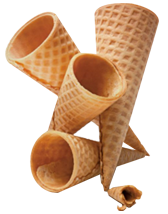The original history of the Fully automatic rolled sugar cone making machine is that it was a German brand, and the machines were very expensive. Chinese machines were cheaper, but the biggest problem was that they did not work properly. The material of the spare parts was often substandard. Additionally, there were issues globally with heaps of waste, and these machines were not serviced properly. When service was available, Chinese technicians demanded high wages, and there was no proper solution.
In many places, including India, those who have Chinese machines now know all these issues. As a result, the Chinese Fully Automatic Rolled Sugar Cone Machine have fallen out of favor, and no one is ready to use them. Vipinbhai Patel, the owner of Tisha Enterprise, experienced these problems firsthand. Since 1995, when he started making molding cones for standard companies like Vadilal, Hamor, and Amul, the demand for rolled sugar cones was very high. In 2010, Vipinbhai Patel went to China twice to inspect and purchase a machine. However, the Fully Automatic Rolled Sugar Cone Machine in Ahmedabad did not work for 12 to 18 months, creating a dire financial situation due to bank installments, warehouse rent, and salaries.
Vipinbhai Patel, passionate about engineering, decided to operate the Fully Automatic Rolled Sugar Cone Machine in Gujarat at any cost. He stood in front of the machine for 15 to 17 hours daily to understand the function of each repair part. He shared his ideas for repairing spare parts with engineers to develop those parts.
After a long effort to replace Chinese repair parts with Indian spare parts, the Fully Automatic Rolled Sugar Cone Machine in India began to run. Despite initial setbacks and financial struggles, including a five-year loan, the only components left from the original Chinese machine were the chassis and the plate. All other parts were replaced by Indian-made components. The chassis and plate were redesigned and developed manually, resulting in a new machine built by Indian engineers. This machine provided satisfactory results.
The machine, operating under one supervision, continues to work properly and deliver good output.



